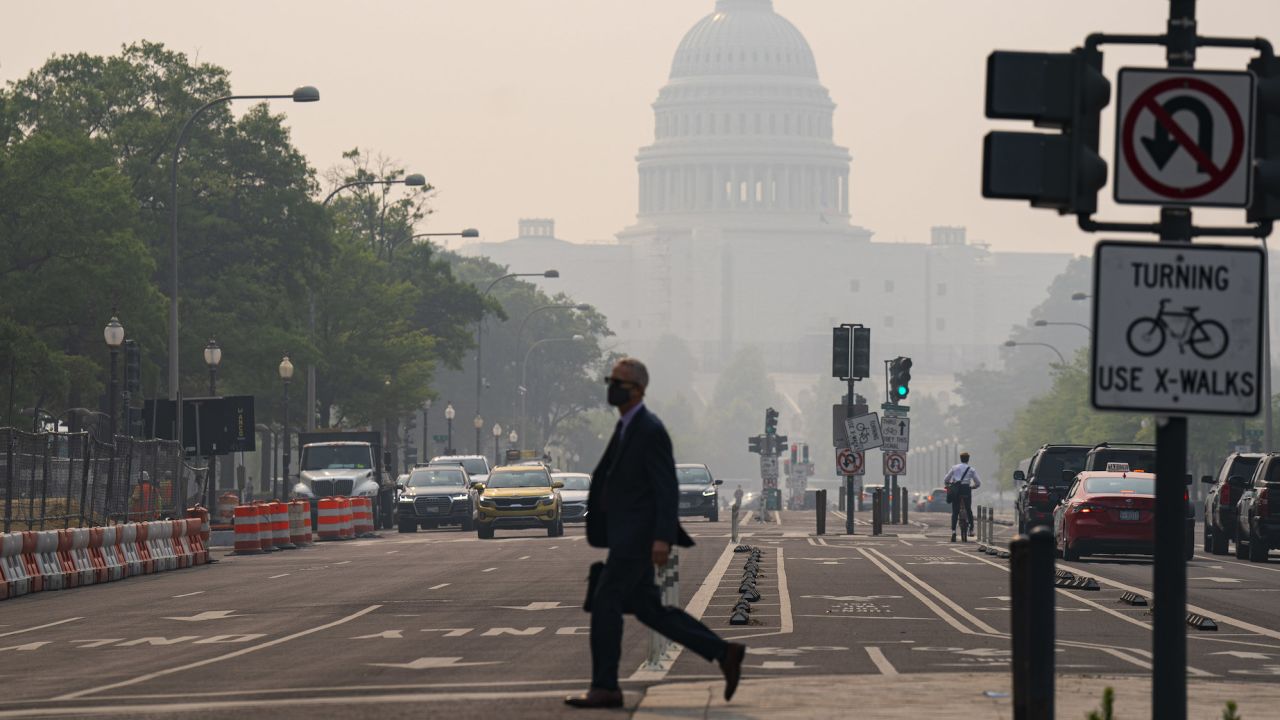CNN —
Air quality conditions over much of the eastern US are forecast to slowly improve this weekend after plumes of harmful air from hundreds of wildfires in Canada traveled south, but schools in some metro areas will undergo remote learning Friday as officials remain on guard about pollution exposure.
While the most severe conditions have passed for most in the Northeast and Mid-Atlantic regions, potentially harmful air pollutants over cities including New York, Philadelphia and Washington, DC, are forecast to linger Friday before the areas slowly clear over the next several days.
“Smoke from Canadian wildfires continues to be transported south by winds into the U.S. resulting in moderate to unhealthy air quality across parts of the Northeast, Mid-Atlantic, Ohio Valley, and Midwest on Friday. Some improvement is expected this weekend,” the National Weather Service said.
The dense clouds of smoke have postponed professional sports games, grounded flights due to poor visibility, shuttered zoos and beaches as well as forced many to mask up when outdoors. Climate experts have warned such events are becoming more frequent due to human-induced climate change.
About 50 million people across several Midwest and East Coast states were under air quality alerts, but that number can change Friday as conditions improve for some.
Here’s what to expect Friday:
- Entire states’ air quality is compromised: All of Pennsylvania, Delaware, Connecticut, Rhode Island, New Jersey and Indiana are under air quality alerts. Parts of Ohio, Michigan, Maryland, Virginia and North Carolina continue to experience those alerts as well.
- Improvements in Canada: Most of the Halifax residents evacuated because of the wildfires will be allowed to return home Friday, Mayor Mike Savage said. About 16,000 people left their homes during the height of the wildfire evacuations and about 4,100 remain evacuated.
- Schools going remote: The potentially dangerous conditions have led officials in New York City, the nation’s largest school system, and Philadelphia to implement remote learning Friday to help reduce exposure to air toxins.
- New York City: After experiencing the world’s worst air quality at multiple points this week, the Big Apple could see some “significant improvement” Friday, Mayor Eric Adams said Thursday morning. “As of right now, the smoke models are not indicating another large plume over the city,” Adams noted as he urged people to mask well when outside.
- Firefighting assistance: On Friday, New York state plans to send forest rangers to help fight the wildfires in Quebec, Gov. Kathy Hochul announced Thursday. At least seven people will travel to Canada over the next two weeks, Hochul added. Federal resources have also been deployed, the White House has said.
The wildfire smoke from more than 400 blazes in Quebec has stopped wafting south after several days of movement, eventually reaching and wrapping parts of the Atlantic seaboard in an orange cloudy haze. In Quebec, smoke from wildfires across the region has been significantly reduced.
Early Friday, New York City’s air quality index was below 150, a designation considered “unhealthy for sensitive groups”, or a level 3 of 6, according to the monitoring website AirNow.
Philadelphia’s air quality index exceeded 150 early Friday, making it “unhealthy.” The city’s air is expected to improve slightly to “unhealthy for sensitive groups” later Friday.
Notably, though, improvements are occurring slowly with only light winds and little change to the current weather pattern, which will keep the smoke trapped closer to the ground until it slowly dissipates.
As of 2 a.m. ET Friday, several metro areas still had “unhealthy” levels of air quality, including Dover, Delaware; Richmond, Virginia; Atlantic City, New Jersey; and Raleigh, North Carolina.
But officials warn that such routine-altering weather events are more likely to continue disrupting daily life as the planet warms, creating the ideal environment for more severe and frequent wildfires. When those flames burn, the smoke can travel thousands of miles, which puts millions more people in harm’s way.

Wildfire smoke is particularly dangerous because it contains tiny particulate matter, or PM2.5 – the tiniest of pollutants. When inhaled, it can move deep into lung tissue and enter the bloodstream. It comes from sources including the combustion of fossil fuels, dust storms and wildfires, and such smoke has been linked to several health complications including asthma, heart disease and other respiratory illnesses.
Due to those possible dangers, US President Joe Biden on Thursday said it’s “very important” that communities experiencing air pollution heed local guidance and check on their neighbors.
Dr. Peter DeCarlo, an associate professor in the Department of Environmental Health and Engineering at Johns Hopkins University, urged people to closely monitor the air quality in their vicinities and limit time outdoors.
“For this week, this is just a situation where we’ve got a few days of pretty poor air quality. … It’s the beginning of summer for many of us who are parents, and maybe we can use it as an opportunity not to run around as much until this poor air quality passes,” DeCarlo said.


